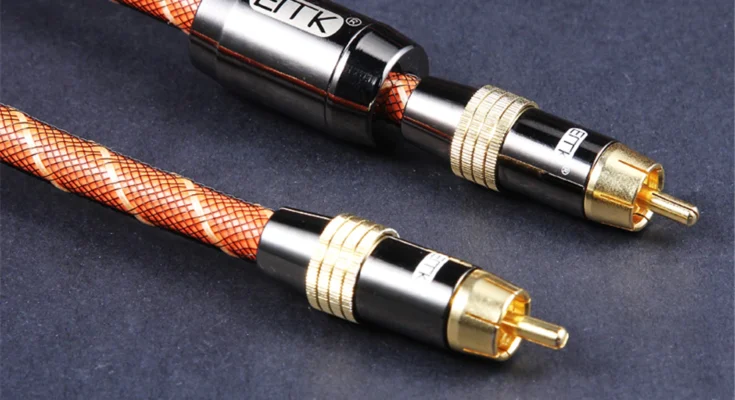Coaxial cable is a type of metal-coated cable that is used to provide conductivity and strength. It is often employed in applications where connecting to an antenna, or another external device is necessary.
Definition of Coaxial Speaker Cable
A coaxial speaker cable, or coax for short, is an electrical cable with an inner conductor surrounded by a dielectric insulation layer covered by another conductive layer called the shield. The term “coaxial” refers to the fact that these cables have a central axis around which they are wound.
Coaxial cables are used in various applications, including computer networking, audio/visual equipment, and radiofrequency (RF) transmission. They are also commonly used to connect cable television (CATV) and satellite TV receivers to televisions.
The main advantage of a coaxial cable is that it can carry signals with little interference. This is because the inner conductor and the shield are electrically isolated from each other, which prevents signal crosstalk. Coaxial cables are also relatively immune to electromagnetic interference (EMI), making them ideal for use in environments with much electronic equipment.
Why Should One Want to Buy It?
There are several reasons why someone would want to buy coaxial cable. First, it is very inexpensive compared to other types of cable. Second, installation is straightforward and does not require special tools or training. Third, it is very rugged and can withstand a lot of abuse. Finally, it is very flexible and can be used in various applications.
Advantages of Coaxial Cable
One of the main advantages of coaxial cable is that it can carry signals over long distances without losing signal strength. This makes it ideal for applications where long-distance communication is required, such as cable television and high-speed internet. Coaxial cable is also resistant to interference from electromagnetic sources, making it a good choice for applications where signal integrity is essential. Another advantage of coaxial cable is that it is relatively easy to install and maintain.
What Are Some True Stories Where Coaxial Cable Saved the Day?
In today’s digital world, it’s hard to imagine a time when coaxial cable wasn’t around. This type of cable helps connect our homes and businesses to the internet, TV, and phone services we rely on daily. But believe it or not, there was a time before coaxial cable was invented.
And while it may not seem like an exciting topic, the history of coaxial cable is pretty interesting. In this article, we’ll look at the origins of this essential piece of technology and some of the true stories where coaxial cable saved the day.
So, what is the coaxial cable? In short, it’s a type of electrical cable that consists of two conductors (copper wire) surrounded by an insulating layer (plastic or rubber). A metal jacket or braid usually shields the inner conductor to protect against interference from external sources.
Coaxial cable was first developed in the late 1800s by English physicist Oliver Heaviside. At the time, Heaviside was working on improving long-distance telegraphy signals and came up with the idea of using two copper wires instead of one. This new design allowed for much clearer signals over longer distances.
Heaviside eventually patented his design in 1880, and it wasn’t long before other inventors began experimenting with similar ideas. One notable example is American engineer John Stone who developed his version of coaxial cable.
Coaxial cable, or coax for short, is an electrical cable with an inner conductor surrounded by a dielectric insulation layer, which is covered by another conductive layer called the shield. The term “coaxial” refers to the fact that these cables have a central axis around which they are wound.
Coaxial cables are used in various applications, including computer networking, audio/visual equipment, and radiofrequency (RF) transmission. They are also commonly used to connect cable television (CATV) and satellite TV receivers to televisions.
The main advantage of a coaxial cable is that it can carry signals with little interference. This is because the inner conductor and the shield are electrically isolated from each other, which prevents signal crosstalk. Coaxial cables are also relatively immune to electromagnetic interference (EMI), making them ideal for use in environments with much electronic equipment.
Conclusion
Coaxial cable is an electrical cable with many advantages over other types of cable. It is more durable, has a lower signal loss, and is less susceptible to interference. A coaxial cable should be your first choice if you need a new electrical cable.
And while it may not seem like an exciting topic, the history of coaxial cable is pretty interesting. In this article, we’ll look at the origins of this essential piece of technology and some of the true stories where coaxial cable saved the day.
So, what is the coaxial cable? In short, it’s a type of electrical cable that consists of two conductors (copper wire) surrounded by an insulating layer (plastic or rubber). A metal jacket or braid usually shields the inner conductor to protect against interference from external sources.




